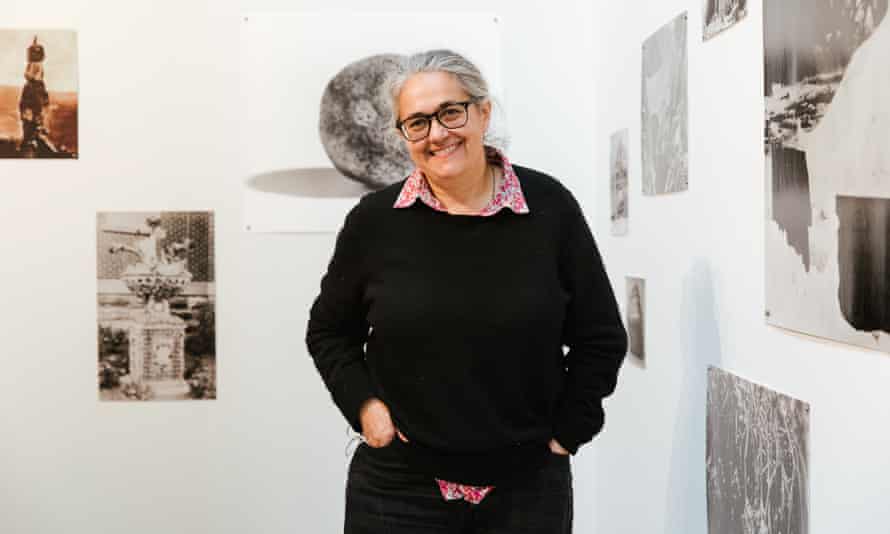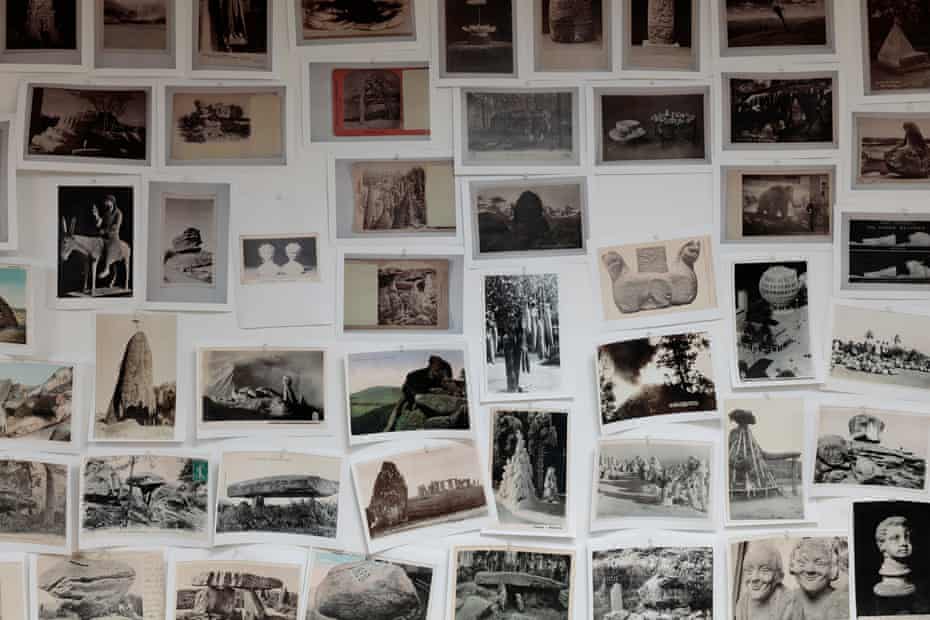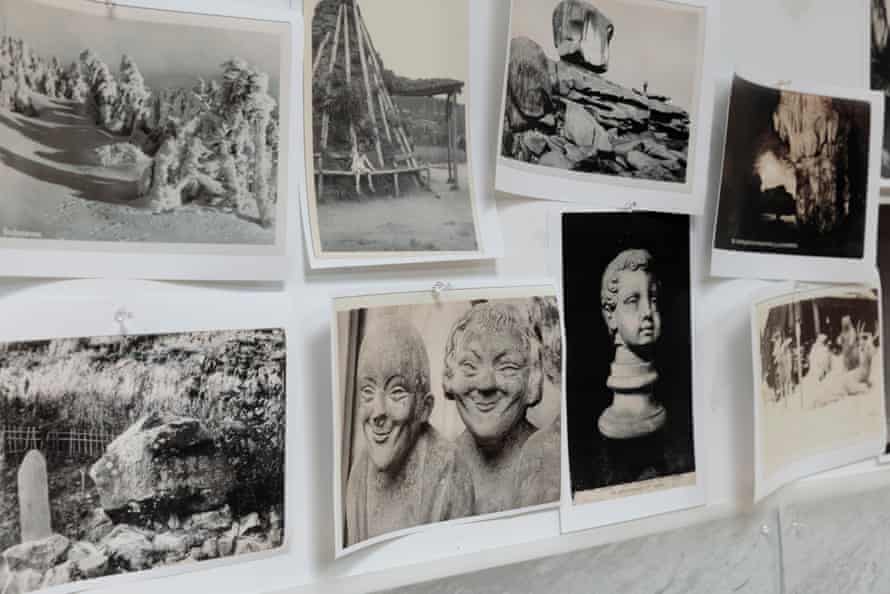 |
| Tacita Dean working on The Montafon Letter, part of the Landscape exhibition at the Royal Academy. Photograph: © 2017 Fredrik Nilsen |
Tacita Dean on the pandemic: ‘We had all this free time – and I was useless!’
During lockdown, the artist made this dirty postcard and little else. Now back on track, she talks about her upcoming shows – and feeling baffled by this new ‘we’re all in it together’ Britain
Charlotte HigginsThursday 27 May 2021
“O
 |
| ‘My single project of 2020’ … Shite Zeit, a postcard by Dean. Photograph: Courtesy the artist |
My favourite work then was an allusive, elliptical film called Antigone, loosely based on the Theban plays of Sophocles, which excavated her own, Oedipus-like limping gait; the vaporous landscapes of Bodmin Moor and Yosemite; and a heartstopping total eclipse of the sun. Now she’s back with a new installation for the Hepworth Wakefield, currently marking its 10th anniversary. So why on earth is she so disappointed in herself?
“Well, you have all this free time,” she says of her pandemic-stilled 2020, “and you think, ‘How am I going to use it? Am I going to be one of these people who makes a drawing every day?’ And of course I wasn’t. I was useless!”

She was “semi-dysfunctional”, she tells me – couldn’t even cut the films she’d already shot (as usual, on 16mm or 35mm, being a champion of the old, vanishing photochemical processes). Meanwhile her pal, the great American painter Julie Mehretu, was using all those cancellations to work super-diligently. So was David Hockney – she made friends with him in Los Angeles, where she was living until 2019, and where she still has a studio. “Every day he’d send us a photo of one of his drawings, the ones that are on show now at the Royal Academy, of spring in Normandy. So his productivity arrived in my inbox every day.”
The worst bit, she says, was when she agreed to be an artist-guest on the Channel 4 show, Grayson’s Art Club, on which Grayson Perry showcased art made by the public during lockdown. “I thought, maybe there are people out there that might want to see that level of dysfunction.” After watching an episode, though, she pulled out. She just couldn’t do it. “There was a sort of jolly-hockey-sticks, we’re-all-in-it-together thing in Britain.” She didn’t feel part of that; everything was so different in Berlin, where she lives.
What she was doing instead was grappling with a task for the Getty Center in LA, where she had been artist-in-residence. The project was an artist’s edition: 100 boxes filled with a selection of little treasures – a postage stamp, a strip of film, a vinyl record. One of the boxes will go on show in the autumn, at Frith Street Gallery in London. Some of the objects, owing to production problems caused by the pandemic, she has made by hand – 100 times over.
One is a copy of a letter written to the 20th-century American art critic Clement Greenberg by his small son, Danny. The original is in the Getty archive. “It begins ‘Dear Father, Hitler …’ with the word Hitler clearly filled in by his mother,” she tells me. “But when I saw it first, it read as ‘Dear Father Hitler’” – no comma. “So during this whole year when everyone else was making great paintings, all I did was write out ‘Dear Father Hitler’ 100 times. A completely pointless thing to be doing and, income-wise, catastrophic.”

She did make one other thing: a postcard. The main image was taken from an old book on alchemy, also from the Getty archive. It looks like a turd falling out of the sky. She added joke words and phrases – “Shite zeit”, “anus horribilis” – as a scatological cry of despair against the pandemic. Then she mailed copies out to her friends. “That was my single project of 2020,” she says, ruefully.
Postcards also form the basis of the new installation in Yorkshire, a response to the art of Barbara Hepworth, the focus of a new exhibition. She’d hoped to go to Athens to film in the Museum of Cycladic Art – Hepworth loved those ancient, stripped-down figures with their folded arms. Of course that didn’t happen. Dean was thrown back on her own resources: her mighty collection of vintage postcards. She’s careful to specify that she likes the old, photographic ones, printed directly from a negative; it’s typical of her to have a feel for the quiddities of a medium that’s fallen out of use.

The installation is a room lined with photographs of these postcards – using film, of course, printed up large on seven different types of paper. It is a piece of visual poetry and connection, where dolmens and stalactites and frozen fountains and pot-bellied men form a story of metamorphosing forms that’s both recognisably a homage to Hepworth’s enthusiasms, and typically Deanian.
She did all this work in her new studio in Berlin. She – plus her husband, artist Matthew Hale, and teenage son – had been living in the city before the LA residency came up in 2014. They’d kept extending their time in LA, not least as the climate was great for Dean’s rheumatoid arthritis, which makes it painful for her to walk and renders typing a frustrating, two-fingered business. In LA a lab had been archiving her films, and she had latterly been designing Wayne McGregor’s new work for the Royal Ballet, the Dante Project, with a score by Thomas Adès. The premiere has been twice postponed but is in the diary, again, for 14 October.
They had to move back to Berlin in summer 2019 to deal with Brexit-related bureaucracy. It was a jolt. “My son and Matthew hated it at first, we couldn’t remember who our friends were.” She bought a new studio in a “Nazi-built spy sort of place”. Beg pardon? She explains that it is a former radio amplification station in West Berlin, once disguised as a house, but very undomestic inside, and with concrete bunkers underneath, now a car park.
She hasn’t been back to LA since before the pandemic, but when we speak she is about to head there again, taking with her three films. Shot on 16mm and 35mm, they are unique copies, she wouldn’t dream of shipping them by courier. One of the works is a filmed double portrait of Mehretu and Luchita Hurtado, the Venezuelan painter who died last year, a few months after the shoot. The work is called 150 Years of Painting, because Mehretu and Hurtado share a birthday and Mehretu was going to turn 50 when Hurtado turned 100. Dean’s kicking herself for not using lockdown to cut the film. “So difficult,” she says. “I promised Julie it wouldn’t be a fade to black, it would be a loop.”
Why such insistence, I ask? She hesitates. “If I tell you, you will write it down … Umm … OK, but it might ruin my ability to ever be able to film anyone again.” It’s all about, she says, “my bad reputation for filming people just before they transition to the other world”. She made a series of filmed portraits, mostly of extremely venerable artists, shown at the National Portrait Gallery in the 2018 exhibition. Oh right, they … died? I ask. No, wait, not all of them: I remember that one was of David Hockney, and he’s still very much alive.

“The film of David was a loop,” says Dean. “Claes Oldenburg, a loop, he’s alive. Cy Twombly, fade to black, died. Merce Cunningham, fade to black, died.” You’re a witch! I say. “Don’t say that!” she replies. But really, I add, come on. These great men were very old. You’ve made what amounts to a fade-to-black portrait of the actor Stephen Dillane, and he’s very much alive. “Touch wood he’s still alive!” she says. At this, she pulls out from under her sweater a pendant of polished wood, and really touches it – in a serious, non-jokey way. It came from Yosemite, she says. Her studio assistant picked it up for her there when they were filming Antigone, because she was constantly looking for wood to touch, especially when anyone mentioned the solar eclipse – if it had been cloudy that day it would have ruined all their plans.
In fact, that whole project was perilous. Dean had devised a camera aperture that would mask half the frame while filming. Later, they’d reverse the masking and film the other side of the frame. All this was done blind: you couldn’t see what you’d already filmed. It could have gone horribly wrong. In the eventual work, you saw two scenes on a single frame, one half shot, say, in Cornwall, the other in the US. But the relationships between each half of the frame were down to chance. Or fate, even. The eclipse, the blinding of the sun, the blind Oedipus, the blind filming process – they were all interconnected.
Except: chance is never quite just chance. As an artist, once you’re in a particular frame of mind, the right things can flow your way as if you’ve ordered them from the universe. Like the way she can find four-leaf clovers, just like that. She doesn’t do that for good luck, she says, she can do it because she’s open to it, she’s ready for it. “I have a quick eye. I can walk across a field and notice an anomaly.” This is why, I think, she’s had a tricky pandemic year: she needs to be in the world, making her way across that field, senses ready for four-leaf clovers, waiting to see where the universe will lead her, playing with chance and making it her own.


No comments:
Post a Comment